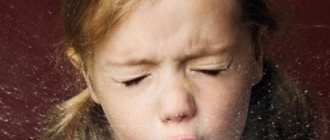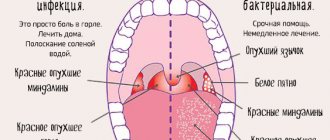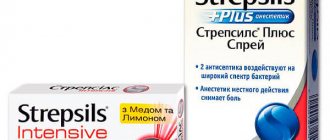If a child begins to complain of severe weakness, he develops a severe, painful cough, and his throat becomes red from inflammation - this means that an infection has entered the body. To help a small patient overcome the disease and prevent possible complications, it is necessary to urgently begin a set of treatment procedures. You can cope with the disease, including at home.
Treatment of cough and sore throat can be done even at home
A cough and red throat can be treated effectively even without going to the hospital - all necessary medications can be taken at home. In addition, in this case it becomes possible to use healing folk remedies, as well as carry out various health procedures.
Causes of cough with a red throat in a child
Most likely , with a red throat and cough, one of the following diseases will be diagnosed:
- Laryngitis. This is an inflammation of the mucous membrane of the larynx, in which additional symptoms include fever and runny nose. Symptoms of laryngitis always develop very quickly, and if a child is exposed to hypothermia, laryngitis will make itself felt the very next day. In childhood, this pathology is dangerous because with improper treatment or its absence, swelling of the larynx can develop as complications. They lead to attacks of suffocation (they are especially obvious at night).
- ARVI . This is a viral infection of the respiratory tract, which is characterized by seasonality. Typically, the disease manifests itself in children in the cold season and is widespread, often spreading in the form of an epidemic. One of the features of ARVI is the unpredictability of changes in body temperature. It can be either critically high (up to 39-40 degrees) or completely absent. But in any case, the child will experience redness of the throat and a cough.
- Tonsillitis. With such an illness, the temperature, unlike influenza and ARVI, always rises, and to very high values (up to 40 degrees). Additional symptoms are chills and fever, aching joints, swollen lymph nodes, and sore throat.
- Scarlet fever . An infectious disease that is easily transmitted by contact in children's groups. At the initial stage, the disease proceeds in exactly the same way as tonsillitis. And only after a day can you detect such a distinctive sign as the appearance of a rash on the skin.
- Pharyngitis. This is an inflammation of the tissues of the pharynx, caused by viruses and characterized by a severe cough, swollen lymph nodes and a feeling of constant tickling, itching and discomfort in the throat. Often, throughout the entire period of development of the disease, the child’s temperature remains at a normal level.
- Tuberculosis, emphysema or lung cancer . With such pathologies, cough is also a typical symptom. But the throat turns red not because of inflammatory processes, but because of irritation from constant coughing. A reason to examine a patient for such diseases may be a prolonged cough without other symptoms characteristic of a cold. Such additional symptoms may be enlarged lymph nodes, fever, and runny nose.
- Measles. An infectious disease that is at first easily confused with a cold. But if the signs of colds cannot be controlled with standard remedies and the symptoms do not disappear within 2-3 weeks, this is definitely measles.
With a red throat, a child may experience different types of cough .
If the cough is dry and barking for a long time, the reasons may be:
- an allergic reaction to some irritant;
- whooping cough;
- diseases caused by adenoviruses;
- viral croup;
- malignant neoplasms in the throat;
- diphtheria.
Types of diseases of the throat and larynx
Throat diseases can be caused by various reasons. Most often, malaise is the result of a bacterial or viral infection, but similar symptoms can also be caused by a fungal infection or even the formation of a tumor. In addition, throat diseases without fever can be triggered by the influence of substances that irritate the mucous membranes, allergies or too dry air.
Infectious diseases
Tumor diseases
Diseases of the throat and larynx can be caused by tumor growth. Tumors are primary (first formed in the larynx) and secondary (metastases of oncological processes in other organs). As the tumor grows, patients begin to complain of a “lump in the throat” or a sensation of a foreign body. The voice may change and become hoarse or hoarse, and difficulty swallowing may occur.
Menthol lozenges are often written “for sore throat”, but menthol itself does not have any therapeutic effect and does not speed up recovery - it only has a weak anesthetic effect and pleasantly cools the inflamed mucous membrane.
Symptoms and treatment of major throat infections
This is perhaps the most common cause of sore throat. Acute respiratory viral infections (ARVI) are characterized by a feeling of dryness, sore throat, sore throat, hoarseness, runny nose, and sometimes sneezing and coughing. The temperature rarely rises above 38 0 C. Antibiotics in this case are completely ineffective, since they are designed to fight bacteria, and ARVI is caused by viruses. In this case, it is indicated to take antiviral drugs, as well as immunomodulators. To relieve the symptoms of ARVI, it is also recommended to rinse with a decoction of chamomile or sage; they relieve irritation. From pharmaceutical products, we can recommend sprays with a mild anesthetic effect and lollipops with sage and eucalyptus. It is recommended to support the immune system by taking vitamin C, and drinking plenty of warm (but not hot!) drinks, for example, herbal teas with rose hips and honey.
Angina
Characterized by high fever (up to 40 0 C) and very severe sore throat. The larynx is red and inflamed. The tonsils are inflamed and covered with a white coating. Frequent companions of sore throat are joint pain and migraine. It is important to know that sore throat can be treated with antibiotics! Remember that untreated sore throat can cause very serious complications, so if you suspect this disease, consult a doctor immediately. For sore throat, bed rest, soft, pureed food and plenty of fluids are recommended. Rinsing also helps relieve pain and cleanse the mucous membranes - rinsing with a decoction of sage, chamomile, linden, a solution of furatsilin and miramistin is especially effective.
Pharyngitis
Distinctive signs of pharyngitis are dry throat, dry cough, soreness, stabbing pain in the larynx, which intensifies when swallowing and trying to open the mouth wide, as well as a feeling of a lump in the throat. The mucous membranes of the throat are red and inflamed, and there may be plaque or pus discharge. When treating pharyngitis, you need to exclude any irritating foods (too hot, spicy and sour) and drink as much fluid as possible, giving preference to drinks high in vitamins. Gargling with a solution of iodinol helps. But in no case should you self-medicate: without proper therapy, pharyngitis easily becomes chronic.
Laryngitis
Inflammation of the larynx and vocal cords. The main sign of laryngitis is a barking cough, a hoarse, hoarse voice or its complete disappearance. Laryngitis is more often diagnosed in young children. The disease is dangerous because in a lying position (usually at night), swelling of the larynx is possible, which leads to difficulty breathing (this is due to the structural features of the children's larynx). In this case, you need to immediately call an ambulance, and while waiting for doctors, lift the child into an upright position and place him in a warm and humid environment to relieve the spasm. This is easy to do in the bathroom by placing your child under a hot shower.
Laryngitis is often accompanied by a scratching sensation in the throat. The disease is accompanied by a cough - first dry, later with expectoration of sputum. Chronic laryngitis is caused not only by bacteria, but also by other factors - vocal strain, smoking, exposure to caustic substances. For laryngitis, inhalations with mineral water (in the absence of elevated temperature) help, in case of difficulty breathing - with “Berodual” or other drugs with a similar effect, warm compresses on the throat, drinking herbal decoctions. You should not strain your voice - doctors advise keeping silent for 2-3 days. To alleviate the condition, you should additionally humidify the air in the room - buy a humidifier or at least hang a wet towel in the room.
Tonsillitis
Under this name lies inflammation of the tonsils. Acute sore throat, fever, enlarged tonsils and purulent plaque on them, bad breath are the main symptoms of this throat disease. Tonsillitis is most often caused by viruses, although bacterial tonsillitis caused by streptococcal infection can also occur. To relieve a sore throat, irrigation and gargling are recommended, and the temperature should be brought down with the help of antipyretics like ibuprofen. Rinsing with a soda-salt solution gives a good effect.
Bacterial throat diseases are characterized by rapid development - in the morning you felt great, and by lunchtime you are completely broken and can barely swallow. With viral infections, symptoms appear gradually. However, only a doctor, after laboratory tests, will be able to give an accurate answer to the question of the etiology of your throat disease: viral, bacterial or fungal.
Symptoms and treatment of tumor diseases of the larynx
Tumors in the throat are insidious - they develop for a long time without showing themselves. Only when the tumor reaches a significant size do symptoms such as discomfort, sore throat, difficulty breathing through the nose, stuffy ears, difficulty swallowing, and bloody mucus from the nose begin to appear. Later, unexplained toothache (even if the dentist finds no problem), ear pain, dry cough, hearing loss, otitis media, nosebleeds, change in voice timbre or loss, and headaches are added to the symptoms. Do not waste time on self-medication and folk remedies. A tumor in the throat is deadly, and there is no way to cope with this disease on your own.
Fortunately, not all tumors are malignant. Benign ones include:
- polyps and papillomas of the larynx;
- cysts;
- angiomas;
- lipomas;
- fibroids.
Treatment
For coughs and red throats, treatment should be aimed at suppressing the causative agent of the disease .
The drugs that will be used for this are prescribed by an ENT specialist or pediatrician.
If the disease is of bacterial origin , you can use antibiotics flemoklav or products based on levofloxacin .
For viral pathologies, such drugs do not work - the use of antiviral agents and immunomodulators (interferon, cycloferon) is required.
- Lavomax;
- isoprinosine;
- remantadine;
- ribavirin;
- arbidol;
- ingaverin.
Basically, such drugs can be used from the age of 5-6 years, and some even earlier.
But a more accurate permissible age should be found in the instructions for a specific drug.
You can get rid of a cough , regardless of the background of what disease it manifested itself, using the following means:
- Gedelix . An expectorant drug made from ivy leaf extract.
- Gerbion. A natural remedy containing primrose root extract. This syrup promotes expectoration of sputum in bacterial and viral diseases of the respiratory tract.
- Erespal. A safe product that can be given even to newborns. In addition to the expectorant effect, the drug helps relieve inflammation in the respiratory tract.
But normalize the condition of the laryngeal mucosa and eliminate painful sensations with the help of such means that at the same time eliminate redness:
- tantum verde (a drug in the form of a solution, spray and lozenges that eliminates pain and relieves inflammation);
- Strepsils (lozenges that have anti-inflammatory and antimicrobial effects);
- kameton (combined action spray).
It must be remembered that sprays and aerosols are contraindicated for children under three years of age due to the risk of bronchospasm.
Each package of medicine contains detailed instructions, with the help of which it is easy to calculate the required dose and frequency of taking the medicine.
The baby's throat is red, what should I do?
A red throat in a baby is a clear symptom of a progressive disease. This illness causes serious inconvenience and discomfort for the child, the cause of which parents may not immediately identify. Proper treatment of a baby’s throat will allow you to quickly remove the resulting swelling and get rid of the underlying disease, the symptoms of which can be snot, cough and runny nose.
Red throat and cough in a child - what to do and how to treat it
This article talks about the causes of red throat and cough in children. Recommendations for taking medications and traditional medicine recipes are also given.
What causes a red throat and cough in a child? Many parents, especially inexperienced ones, immediately panic when they discover such symptoms. And they immediately begin to treat the baby with “proven” means.
Causes
Let's find out why an adult's throat may turn red.
- Pharyngitis is a common cause of this symptom. Redness in the throat is one of the symptoms of pharyngitis in adults. In this case, it is more pronounced on the sides and at the far end of the pharynx. The upper palate and arches also swell a little and turn red.
- ORZ . This common disease can also cause a red throat. In this case, the disease will pass quickly and antibiotics are not required for treatment.
- Various respiratory viral infections . There can be quite a lot of them, but they are all treated according to the same principle. And almost all cause redness of the throat.
- Diseases such as rubella and chickenpox rarely affect adults (most have immunity since childhood), however, this does happen. In this case, the redness of the throat will also be pronounced.
- Tonsillitis in the acute phase. This is the so-called sore throat. This disease is caused by bacteria and requires antibiotics to treat it. Sore throat is a dangerous disease, as it can lead to complications and severe, painful consequences in the form of ulcers in the throat, etc.
- Some diseases of the digestive system can also be the culprits of redness of the throat. For example, a disease such as dyskinesia, which affects the bile ducts, has just such a symptom.
- Allergy is a very likely cause of the symptom. In this case, redness of the throat is caused by “volatile” particles that enter the body through inhalation: particles of dust, pollen, animal hair. Other allergens: foods, medications cause a red throat much less frequently. But how to determine that an allergy or cold has appeared, and what means you can get rid of the disease, is described in this article.
Video of a red throat in an adult:
Causes of a combination of cough and sore throat symptoms
Of course, symptoms such as a child’s red throat and cough cannot be ignored. But self-medication is not entirely wise. Such symptoms can be either a common cold or indicate a more severe illness. It is best to contact your pediatrician as soon as possible.
What can cause these symptoms? There are many reasons. But most often, if a child has a dry cough and a red throat, then some kind of infectious disease can be assumed.
Folk remedies
If a child has a sore throat, alternative medicine will help improve the general condition. Since the child’s body is extremely susceptible, doing this without consulting a pediatrician is unacceptable.
To get rid of pain and sore throat, gargling oil will help, for which you need:
- finely chop the onion (it is best to use a regular onion);
- fry it in a large amount of vegetable oil until a crust appears;
- With the mixture formed in this way, when cooled, gargle at least three times a day.
You can also prepare medicinal juice yourself. To do this, combine half a glass of beet and carrot juice. It is important to use freshly prepared drinks, in quantities of no more than 100 ml. Add a spoonful of linden or acacia honey to the healthy vegetable juice, then mix thoroughly. It is recommended to consume the concentrate before bedtime, warm.
Mustard foot baths will help to cope with a sore throat in a child if there is no fever. Their preparation is carried out in this way: add two tbsp to a bowl of hot water. l. powder. It should dissolve well and evenly, after which you can start steaming. The duration of the procedure should be no more than 10-15 minutes; if the child is uncomfortable, it is better to stop the intervention. After this, the feet are dried and woolen socks are put on.
The fastest way to deal with a sore throat in a child is in the initial stages of the condition. Parents are advised not to wait longer than two to three days, but to begin treatment immediately. Teas with honey, herbal drinks, and warm milk will be beneficial. This will soften the nasopharynx and neutralize the inflammatory process.
Treatment
You need to know that symptoms such as cough and redness in the throat are caused by viral or bacterial infections. The main thing is etiological treatment, which consists of the use of antibiotics and antiviral agents.
Table No. 1. Antiviral and antibacterial agents:
| Antibiotics - for sore throat, pneumonia, bronchitis. | Antiviral - for respiratory infections. |
| Flemoklav is a broad-spectrum antibiotic. The active ingredient is amoxicillin. Available in tablets. | Cycloferon is a broad-spectrum immunomodulator. Antiviral, anti-inflammatory drug. The active ingredient is meglumine acridone acetate. Available in the form of tablets or liniment 5%. |
| Tavanik - pale yellow tablets. The active ingredient is levofloxacin hemihydrate. | Lavomax is an antiviral agent based on tilorone. Works against most respiratory infections. Allowed for children from 6 years old. |
At the same time, the doctor will prescribe symptomatic treatment.
Table No. 2. Cough medications. Anti-inflammatory drugs for the throat:
| Against cough | For redness in the throat |
| Herbion with primrose. Herbal preparation. The active ingredient is primrose root extract. The syrup is indicated for acute respiratory infections and acute respiratory viral infections as an expectorant. | Cameton is a combination drug in the form of a spray. Active ingredients: camphor, levomenthol, chlorobutanol hemihydrate, eucalyptus oil. Has a complex effect on redness in the throat. |
| Erespal is a cough syrup based on fenspiride. The drug has anti-inflammatory and bronchodilator effects. Allowed for children from birth. | Strepsils - lozenges. Active ingredients: 2,4-dichlorobenzene alcohol, amylmetacresol. Has an antimicrobial effect. |
| Gedelix - has a mucolytic and expectorant effect. Available in the form of drops. The active ingredient is ivy leaf extract. | Tantum Verde - Available in the form of lozenges, spray and solution for topical use. The active ingredient is benzydamine hydrochloride. Has anti-inflammatory and analgesic effects. |
It must be remembered that sprays and aerosols are contraindicated for children under three years of age due to the risk of bronchospasm. Each package of medicine contains detailed instructions, with the help of which it is easy to calculate the required dose and frequency of taking the medicine.
The price of these medicines varies. Therefore, you can easily choose drugs that are affordable for any wallet. You can learn more about drugs for treating throat and cough from the video in this article.
In addition to drug treatment, the doctor may recommend physiotherapy, massages or traditional medicine treatment.
Komarovsky about the problem
Everyone knows how a sore throat manifests itself.
The child refuses to eat because swallowing gives him discomfort, and even giving him tea or compote is sometimes almost impossible. However, few parents imagine exactly what processes occur in the child’s body. The mucous membrane of the larynx has a lot of nerve endings, which is why the range of sensations during a sore throat is so wide - from soreness and tingling to acute pain that prevents you from speaking or eating normally. Inflammation is usually caused by viruses, less often by bacteria. There is another reason - allergens from the outside (dirty air, household chemicals, etc.).
There are many reasons, but there is only one way out - to act and not wait for everything to go away on its own. Komarovsky recommends that you never ignore your baby’s complaints about his throat.
If the baby does not know how to gargle, Komarovsky advises not to torment him, but to use pharmaceutical antiseptics, which can be given in the form of a lozenge or splashed into the throat.
Evgeniy Komarovsky calls Faringosept one of the safest and most effective drugs, but these tablets are not suitable for children under 3 years old, since they practically do not know how to dissolve the drug, and strive to chew it as quickly as possible.
A compress for a sore throat is a rather questionable method, says Komarovsky, since it can cause much more harm than potential benefit. For example, warm compresses for a sore throat are a sure way to end up in the hospital and take a long time to treat severe inflammation, which has become worse after warming up the throat. Compresses should absolutely not be given to children who have an elevated body temperature.
Doctor Komarovsky will tell you how to properly treat a sore throat in the next video.
How to gargle a child’s red throat: choosing a safe remedy
The immunity of young children is unstable and the more often they get sick, the more susceptible they are to new attacks from viruses and bacteria.
The first symptoms of a cold are usually a runny nose and sore throat. In order to prevent discomfort when swallowing from developing into a sore throat or advanced pharyngitis, it is important to immediately begin to take measures as soon as the child complains that he has a sore throat.
The most accessible and effective ways to treat a sore throat are gargles; in this article we will talk in detail about how to gargle a child’s sore throat and whether it is always necessary to resort to drug therapy.
Causes of red throat in children
A child's throat is examined
Redness of the throat in a child is most often caused by a viral infection, but there may be other causes of hyperemia of the mucous membranes:
| Cause of red throat | How does it manifest itself? |
| Infectious and viral diseases | Redness of the mucous membrane of the oropharynx can be caused by viruses, bacteria, and fungi. Often this is one of the signs of tonsillitis, pharyngitis, sore throat, and herpetic stomatitis. A red throat, swelling of the pharynx and difficulty breathing in pediatric practice can sometimes indicate diphtheria or scarlet fever - rare infectious pathologies that require hospitalization of the baby. |
| Burn of the mouth and pharynx | Thermal or chemical. In these situations, redness of the throat is caused by drinking hot drinks, performing thermal inhalations, or contact with chemical liquids and will be accompanied by a burning pain that gets worse when swallowing and trying to take food or liquid. |
| Exacerbation of chronic diseases | With an exacerbation of rhinitis or laryngitis, pathological discharge from the nose and larynx will additionally irritate the mucous membranes of the pharynx, which leads to its hyperemia, swelling and discomfort when swallowing |
Sometimes hyperemia of the mucous membranes of the oropharynx in young children can be one of the symptoms of active teething, therefore, to clarify the diagnosis of the baby, it is best to show the baby to a pediatrician rather than self-medicate.
Hyperemia of the pharynx during teething
Important! A red throat during teething in a child, a runny nose and cough do not always require medication; in most cases, just drinking plenty of fluids and frequently ventilating the room where the baby is located is sufficient.
Gargling in children: medications and folk remedies
If a child’s throat is red, then do not rush to give him various tablets or use sprays - try to resort to a “softer” method of therapy - rinsing.
Important! As a rule, gargling is not prescribed for a child under 3 years of age, since children of this age do not yet know how to retain liquid in their throats and may accidentally swallow the solution or choke.
Medicinal preparations for rinsing
When choosing a drug for gargling for a child, be sure to read the rules for using the drug - instructions are included for this.
Safe and approved for use for young children are:
- Miramistin solution - this product does not need to be diluted with anything, the solution is effective against viruses, bacteria, fungi;
- Chlorhexidine is a transparent antiseptic solution that does not have an unpleasant odor or taste, can be used from the first year of life in the absence of individual intolerance to the active component of the drug;
- Furacilin is an antiseptic with powerful antimicrobial, antiviral and antifungal effects; the solution is effective both for minor inflammation and for purulent sore throat.
Important! These drugs, although they have a small list of contraindications for use, should be used for children only with the permission of a doctor, and carefully follow the instructions and make sure that the baby tolerates the medicine well and does not have individual intolerance.
Does your child have a red throat and snot?
In this case, gargling with Chlorophyllipt or Rotokan will help - these are preparations based on extracts of medicinal plants that have the following effects on the nasopharynx and larynx:
- moisturize mucous membranes;
- heal small cracks and wounds;
- increase local immunity;
- enhance the effect of general medications (for example, antibiotics, if the child has been prescribed this by a doctor);
- kill microbes at the site of localization of the inflammatory process;
- speed up the healing process;
- eliminate sore throat and reduce the amount of nasal discharge.
Important! Rotocan and Chlorophyllipt are alcohol tinctures, therefore, in order to avoid the development of side effects and allergic reactions, the drug should be diluted correctly and a sensitivity test should be performed on the child. As a rule, these drugs are not used to treat the throat of a child under 3 years old.
Red throat in a child: traditional methods of treatment
Preparation of soda solution
If a child’s red throat does not go away and he complains of pain when swallowing, it is necessary to show the baby to the doctor again and take swabs from the throat to determine the causative agent of the infection. You can reduce discomfort in the throat using traditional medicine recipes.
Below are the most effective treatment methods:
- soda solution is a safe hypoallergenic product that is easy to prepare with your own hands. A soda solution quickly relieves sore throat, reduces the amount of mucus, eliminates cough and runny nose, and flushes out pathogenic accumulations from the recesses in the tonsils.
- Soda-salt solution - unlike the drying effect of a regular soda solution, a product with the addition of table salt, on the contrary, moisturizes the mucous membranes of the oropharynx, promotes better expectoration of sputum, washes out accumulated purulent plugs in the tonsils and prevents the spread of infection further - to the respiratory tract. To enhance the antiseptic effect and destroy pathological microorganisms, you can add 1-2 drops of alcohol tincture of iodine to the soda-salt solution, but only if the child does not have thyroid diseases.
- A decoction of medicinal herbs - chamomile, St. John's wort, sage, and calendula have natural anti-inflammatory and antiseptic effects. The decoction must be prepared at the rate of 1 tablespoon of dried flowers per 1 liter of water, boil in a water bath, leave, strain and use for rinsing while lukewarm. Every day you need to brew a fresh portion of the solution.
Important! Children who are genetically predisposed to allergic reactions, as well as children with a history of bronchospasm and urticaria, should use decoctions of medicinal herbs with caution, as they can provoke swelling of the pharynx and larynx.
If a child has a red throat for a long time, then do not neglect a visit to the otolaryngologist - you must definitely find out the cause of this condition and undergo a course of treatment if necessary. For chronic inflammatory processes in the pharynx and nasal cavity, rinsing alone will not be enough; this procedure will only reduce the intensity of clinical symptoms, but will not solve the problem.
The video in this article describes in detail the methods of treating chronic inflammatory diseases of the oropharynx, however, this information is for informational purposes only and cannot replace an examination with a doctor.
Red throat in a newborn baby
Newborn baby crying
It would seem that mothers of newborn babies have nothing to fear that the child may have a sore throat, but sometimes this happens and it is important to act correctly in order to prevent the progression of the pathological process.
It is quite simple to recognize that a baby is bothered by a sore throat - when trying to take a breast or a bottle, the baby begins to cry, he sleeps poorly and often wakes up, and behaves restlessly. If you look into the child’s mouth, you will notice that the tissues of the pharynx are markedly hyperemic and somewhat swollen.
The causes of redness of the throat in a newborn child are different - from hypothermia and the development of a cold to an allergic reaction due to inhalation of tobacco smoke or chemical vapors. In the latter case, it is important to properly provide emergency care to the child, since an allergic reaction can quickly progress, causing swelling of the airways and suffocation.
Important! If redness of the throat is detected in a newborn or infant, you should immediately seek qualified medical help; sometimes the delay of parents and their attempts to self-medicate is the price of the baby’s life.
Walking with a red, sore throat
Walking with your child in the fresh air
Many parents are interested in the answer to the question: is it possible for a child with a red throat to go for a walk? It all depends on the baby’s condition: if the disease is accompanied by an increase in body temperature and signs of general intoxication of the body, and the child himself is capricious, lethargic and weak, then there can be no talk of any walks until the condition improves.
If the baby doesn’t complain about anything other than a sore throat and behaves actively, then going for a walk is possible and even necessary! Fresh air promotes a speedy recovery, improves appetite, clears the airways of mucus and dust, and saturates the lungs and blood with oxygen.
A child always has a red throat, frequent colds and constant complaints of pain when swallowing require a comprehensive comprehensive examination, not only from an ENT specialist, but also from other highly specialized doctors - a gastroenterologist, an allergist, an endocrinologist, an infectious disease specialist. Timely diagnosis and completed course of therapy will help avoid the disease becoming chronic and many other complications.
Source: https://gorlor.com/procedury/poloskaniya/chem-poloskat-rebenku-krasnoe-gorlo-342
Foreign object entry
If you have a sore throat and cough without fever, this may be a sign that there is a foreign object in it.
Fish bones, small metal objects, or toothpicks can get stuck in the mucous membrane. They can pose a real danger.
Damage may occur not only to the mucous surfaces, but also to the esophagus.
If there is a foreign object, it becomes painful to swallow, there are unpleasant sensations, a cough may appear, and the breathing process becomes difficult.
You should not attempt to remove foreign objects yourself. The situation could get even worse. In this case, it is better to contact a specialist in time.
When else can your throat hurt?
In infants under 1 year of age, the most common cause of sore throat is viral infections. They do not need to be treated with antibiotics, says Evgeniy Komarovsky, since antimicrobial agents that successfully fight bacteria have no effect on viruses.
If a red throat is accompanied by the appearance of a rash in the form of watery blisters on the arms, legs, and also in the mouth, we can talk about the Coxsackie virus.
Throat problems accompany infectious mononucleosis and various injuries to the larynx, which is not so uncommon considering how often children put anything that doesn’t fit well into their mouths.
However, if the pediatrician takes a smear from the larynx and finds streptococci in it, then a diagnosis of “angina” will be made, and there will be serious treatment with antibiotics, which parents should under no circumstances refuse if they value the health of their beloved child.










